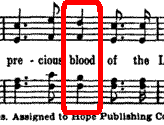The O/C And An Irregular Bass (Part 2)
Often the last stanza of a song's verse or chorus will have "irregular" bass movement. A few examples of this can be found in the last stanza of There Is Power In The Blood. Below is the hymnal version and O/C version of the last line.

Last Stanza - Hymnal Version Last Stanza - O/C Version |
On the third beat, on which we would play the octave, the chord is clearly indicated. We have a Bb, D, and F, which are the notes of a Bb Major Chord. The fourth beat (comprised of a dotted eighth and sixteenth note) is not so clear, however. The notes of the dotted eighth note (F, C, and A) indicate that an F Major chord should be played. The notes of the sixteenth note (F, D, Bb) however, require that a Bb Major chord be played.
 |
Obviously, with the limited time available to play this one beat in the course of the song, a compromise must be made. We must either play an F Major chord or a Bb Major chord on the fourth beat. In playing both possibilities, it should be clear that the Bb Major chord sounds better in this context, and should be the choice used to accompany the fourth beat.
Some pianists prefer a more analytical approach as to why the Bb Major chord should be used as opposed to the F Major chord. For this type of learner, I offer a more logical explanation: The first and third beat of a measure are the dominant beats, and the second and fourth are the weaker beats of a measure. In our example, on the third, stronger, beat, we play a Bb Octave (as indicated by the music). The fourth beat (in the hymnal version) temporarily moves to an F Major chord, but returns to the Bb Major chord within the same beat. Since the third beat is being played as a Bb Octave, then the fourth, weaker, beat should use the matching Bb Major chord. The F Major chord is merely a passing chord that, while not unimportant, is adequately implied by the movement of the Soprano and Alto voices. All in all, maintaining the Bb O/C pattern through the third and fourth beats delivers the desired effect and chordal support for the passage in question.
 |
Also in the last stanza is another common chording situation. In this example (taken from the second to last measure), the first and second beats use the F Major O/C pattern. The third beat, retains an F in the bass, but the notes (F, Bb, and D) are the notes of the Bb Major chord. The fourth beat is an easily recognizable F Major chord.
When examining what to play in a situation such as this, one should follow the music. The bass note given is an F, so an F O/C should be played. This does not contradict the Bb Major chord, which includes an F anyway, but it does allow a consistency to the flow of the bass line. It would not be advisable to play a Bb octave on the third beat, even though that is the chord named, because since the sustain pedal is held through the fourth beat, the Bb would be superimposed onto the F Major chord, which would not sound good at all.
Situations like this occur in almost every hymn, sometimes lasting only one beat, like the example cited, sometimes lasting two beats, and sometimes (but not often) lasting a measure or more. General guidelines are as follows:
- Play the bass note indicated, unless you have special reason to do otherwise.
- Play the chord indicated, remembering that the bass note does not always name the chord that needs to be played.
- Your ear is the final authority. Play what sounds best, and adjust if necessary.
